Menus
- Where does the 790 Duke fit in??
- The orange KTM 790 Duke
- The green Kawasaki Z 900
- Driving behavior of the Z 900 enthusiastic
- The red Suzuki GSX-S 750
- GSX-S 750 ergonomically a bit old-fashioned
- The yellow Ducati Monster 821
- Monster 821 with the best tire
- The blue Yamaha MT-09 SP
- The white Triumph Street Triple R
- Streety impresses with its low consumption
- MOTORCYCLE test result
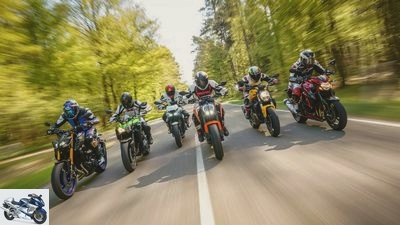
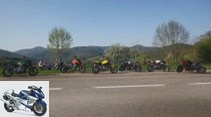
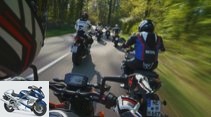
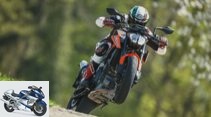
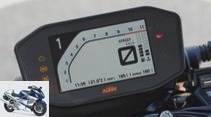
31 photos
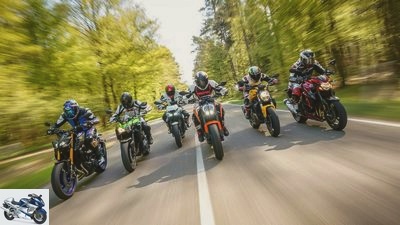
1/31
Yamaha MT-09 SP, Kawasaki Z 900, Triumph Street Triple R, KTM 790 Duke, Ducati Monster 821 and Suzuki GSX-S 750 in comparison test.
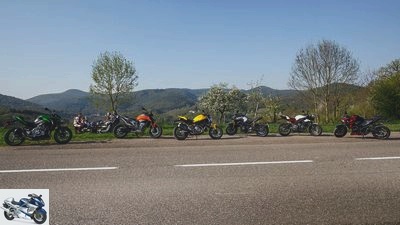
2/31
Colorful cauldrons: a rich color palette of the Nakeds, now even more colorful.
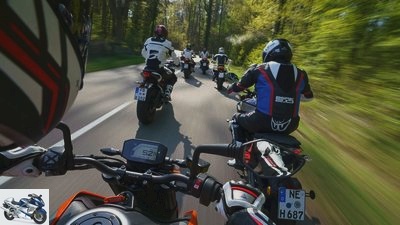
3/31
Country road, the natural habitat of all naked bikes. This time the easternmost tip of France between Strasbourg and Bitsch. Splendid!
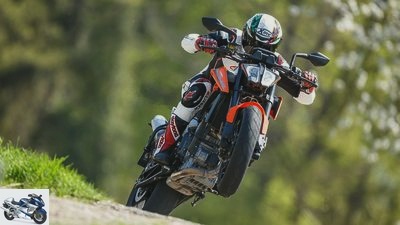
4/31
Orange: KTM 790 Duke.
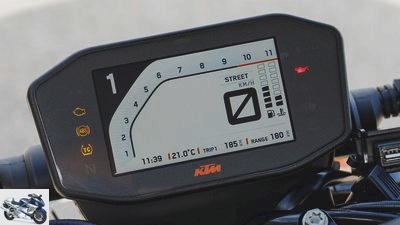
jkuenstle.de
5/31
TFT, yeah: high-contrast, quite large and mostly easy to read. Menus that take some getting used to, good buttons.
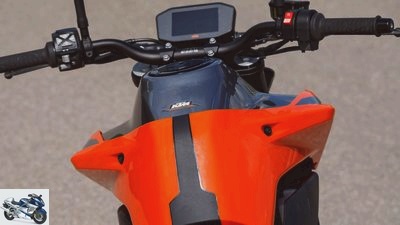
6/31
An incredibly narrow waist and handlebars that are inviting to moderate engagement make the filigree Duke an ergonomics queen, even with space for tall people. If only the bench was more handy.
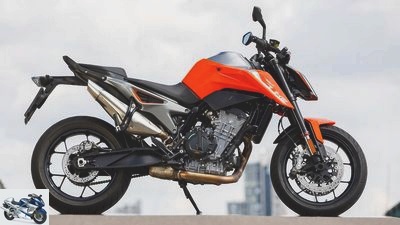
7/31
Schmalz like a big one: the 790 can do high starterles, but the TC needs to be completely deactivated.
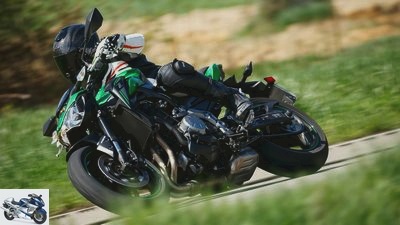
8/31
Green: Kawasaki Z 900.
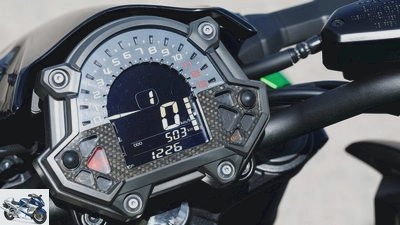
9/31
LCD, oh dear: Stevie Wonder could not make friends with this cockpit either. After all: good readability.
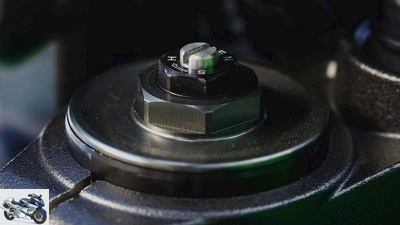
10/31
Even without adjusting the settings, the Z 900 drove brilliantly, and the value of the chassis surprised. It’s nice that you could still adjust. A very harmonious, mobile package.
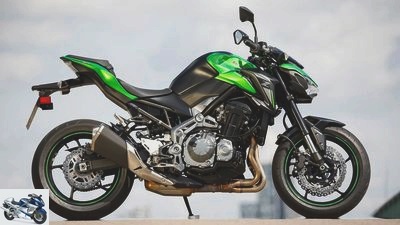
11/31
Sugomi taste: green, beefy, mean. Inexpensive processing, for example on the swing arm. Original seat too low.
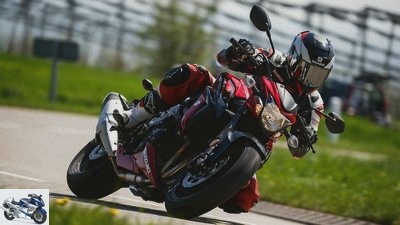
12/31
Red: Suzuki GSX-S 750.
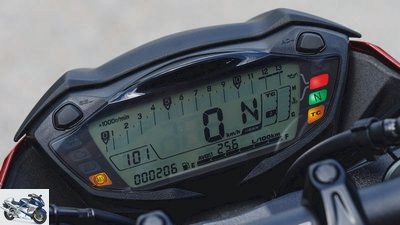
13/31
LCD, totally okee: the tachometer should be more prominent, the rest is easy to read, clearly structured and attractive.
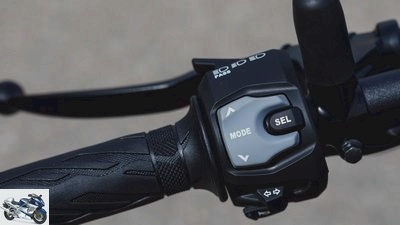
14/31
The Suzuki looks beefy, but less compact than the Kawa in terms of ergonomics. The latter has a good three-stage traction control, which can be adjusted on the left handlebar end.
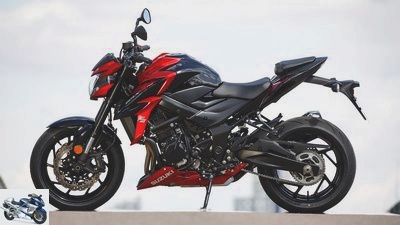
15/31
Fahrwerkelt in the upper test center field. Brakes crisply. Is cheap. The slightly pale engine alone prevents bigger things.
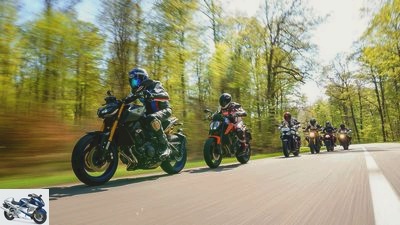
16/31
Interim balance: orange before green before red.
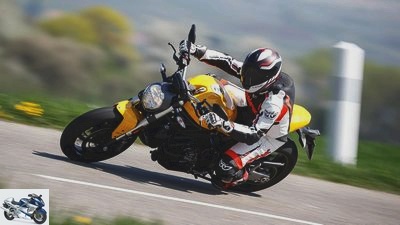
17/31
Yellow: Ducati Monster 821.
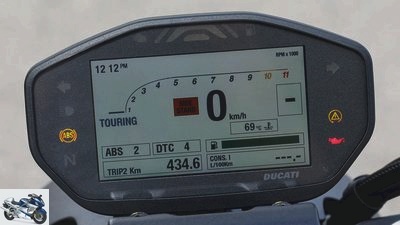
18/31
TFT, also okee: a bit small, less high-contrast, but nice to look at and with a lot of information. Operation from the handlebar.
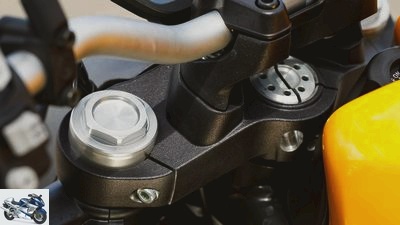
19/31
Typically monster: a deep hollow cemented the driver, handlebars way up front, footrests also high. Kind of cool. For the simple fork, however, you want more damping.
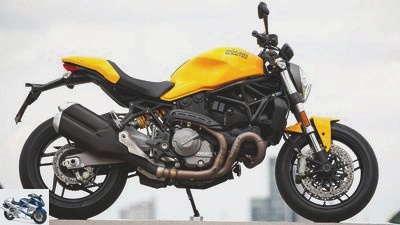
20/31
Aslant? There is even more, the Duc has high reserves, which can be fathomed thanks to the great Rosso III. Also cuts a fine figure in front of the cafe.
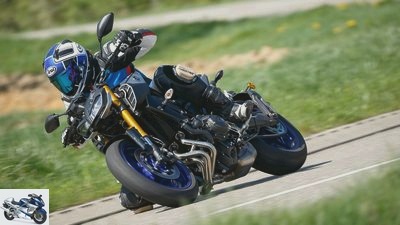
21/31
Blue: Yamaha MT-09 SP.
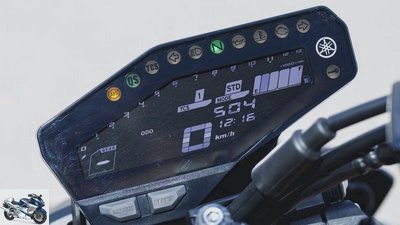
22/31
LCD, basst scho ’: very small, but well in the field of vision and rich in contrast. Quickshifter light in green irritates.
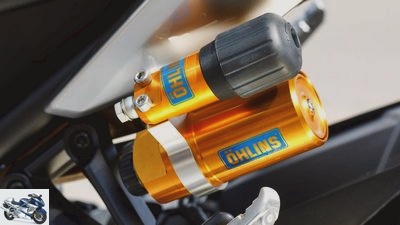
23/31
Two tones of gold: good Ohlins on the back with a handwheel for pre-tensioning,…
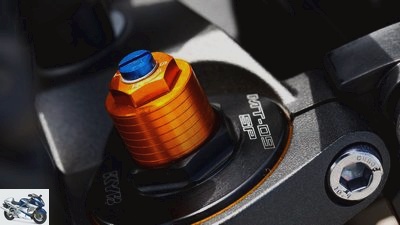
24/31
…at the front, contrary to popular belief, almost even better Kayaba. Fully adjustable and not only beautiful, but also highly functional. Smooth dampening, with a good setting range. Creamy feedback.
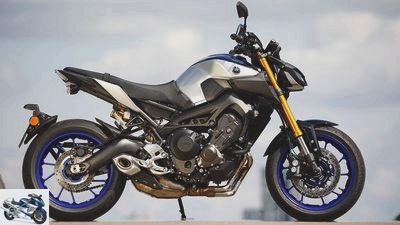
25/31
High at the front, flat in the middle, deep notches: the ergonomics of the MT-09 remains, even as SP, comfortable, but somewhat inactive. Tour Sumo!
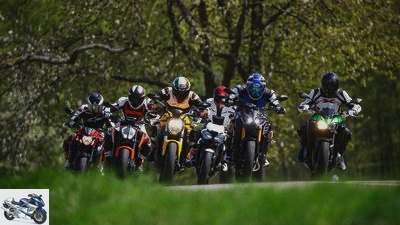
26/31
Close together: One will win by a very thin margin.
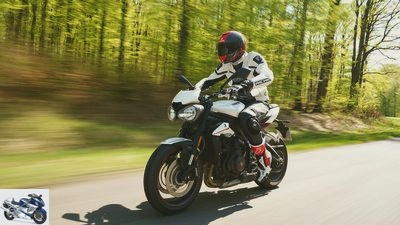
27/31
White: Triumph Street Triple R.
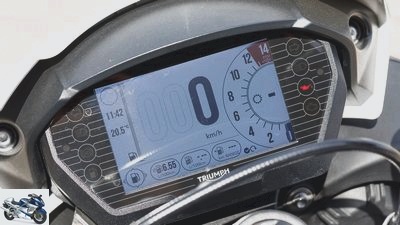
28/31
TFT, also nice: attractive preparation of a lot of information in “styles”. Reflecting in the sun. Operation by joystick.
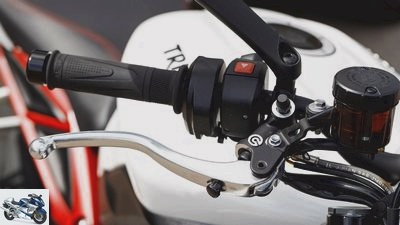
29/31
The Duc also has Brembo calipers, a radial brake cylinder from the same house only the Triumph. Leaky finish at all streeties.
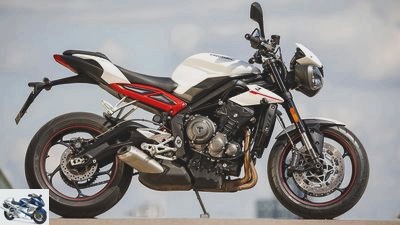
30/31
The ergonomics of the Street Triple R are comparatively front-wheel-oriented. Not uncomfortable, but with a fair amount of exercise. so it is right!
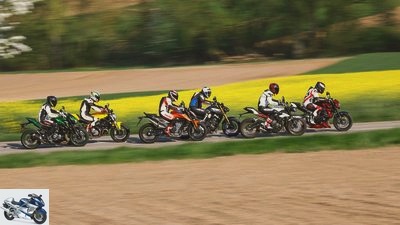
31/31
The verdict: white before orange before green. Thank god none remains gray.
6 naked bikes tested
Where does the 790 Duke fit in??
The new KTM 790 Duke competes against the models Ducati Monster 821, Kawasaki Z 900, Suzuki GSX-S 750, Triumph Street Triple R and Yamaha MT-09 SP in the comparison test of Power Naked Bikes over 100 hp.
More color makes life more colorful, and more colorful is generally better. Need an example? A rainbow is more beautiful than concrete. This attitude can be understood politically, but here it refers to motorcycles, where else would you go? The thing about diversity applies to all classes, but especially to the important naked bikes over 100 hp and under 1000 cubic meters. This attractive segment is traditionally beautifully mixed: Ducati’s L-twin roadster, the Ducati Monster 821, can historically refer to its yellow forefather from 1994. Japanese inline four-cylinder engines come in two colors this year. Green in the case of the Kawasaki Z 900, last year’s winner of the mid-range comparison. Suzuki’s three-quarter-liter naked egg with athlete genes, the Suzuki GSX-S 750, competes in red. The other blue ones, Yamaha, turned their backs on the inline four in the course of the MT revolution – not to their disadvantage, as the enormously successful three-cylinder MT-09 proved. Which at this rendezvous as sharpened on the chassis side Yamaha MT-09 SP comes up with an even deeper color depth. Ultramarine, so to speak. Finally in white the Triumph Street Triple 765. White as innocence? More like the blank slate, because the simpler Streety S basic version was used for the 2017 comparison. The R-variant, which is finely tuned in terms of engine, chassis and other equipment, faces the competition for the first time.
Buy complete article
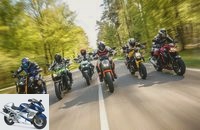
6 naked bikes tested
Where does the 790 Duke fit in??
Where does the KTM 790 Duke fit in??
In any case, KTM is enriching this varied spectrum with a shimmering orange facet from this season. If you fade out 125 and 390 Duke, the Mattighofen troop dares to make the first step into a real volume class with the KTM 790 Duke. The Duke rolls into a field that is colorful but takes place in the tough competition. Hardly any other segment has such a high level of competitive pressure, performance density, and offers as much “bang for the buck”. What counts first and foremost is driving fun, entertaining engines and perfectly functional add-on parts. A little whistle, uniqueness, doesn’t hurt. Suitability for everyday use is also a top priority. After all, the calculations are sharp, the class is price sensitive. A clever cost-benefit calculation counts more than anywhere else. Spending money where the driver benefits from it. And save where you just don’t notice it. At the presentation, KTM announced confidently, fully committed to the competition-oriented company philosophy of wanting to put together nothing less than the best mid-range package ever.
The orange KTM 790 Duke
For the oranges, it looks like this: 800 series twin-cylinder, characteristically punched with 75 degrees crank pin offset, hanging in the steel bridge frame, supplemented by a simple WP chassis that can only be adjusted in the spring preload. As an ace, the Austrians have pushed their high-end control electronics in the form of IMU-fed ABS and traction control along with four driving modes up their sleeves. 105 PS strong, 187 kilos light, costing almost 10,000 euros.
KTM 790 Duke.
Since the driving report and top test, we have known that it was no surprise anyway to see the qualities of the KTM 790 Duke as a driving machine focused on playfulness. A motorcycle with an extremely lively engine, balanced sporty ergonomics and appropriate peripherals, not just for this performance class. A motorcycle that placed the kick on the country road at the top of the specification sheet and underlined it with a highlighter, but has not lost sight of everyday life with slim ergonomics, reasonable comfort and pleasantly moderate drinking behavior. We know about good brakes, and even very good assistance systems. But nicknames are also experienced. A naked bike for around 10,000 euros would certainly look good with adjusting screws for the dampers, as well as better response behavior of the spring elements. With a view to the much discussed first tire, the Maxxis Supermaxx ST touring tire, the last word has probably not yet been spoken. So where does orange fit in in the spectrum of the bare middle? Come on with the complementary colors. The reference directly to determine the position.
The green Kawasaki Z 900
The Kawasaki Z 900 has undoubtedly set the benchmark in the middle class since last year’s naked exchange on points. In retrospect, this is not so surprising, as the Zett, with its 948 cubic inline four-cylinder and 125 hp, simply interpreted the term middle class in a lax way. Just not in terms of price, because for around 9,100 euros, the Sugomi Roadster still offers an unbeatable amount of motorcycle for the money. But it’s not the mighty Inline-Four that is the real figurehead, but the model student handling. What the Z 900 can currently do better than everyone else here: work brilliantly with decent, but not overly cheeky parts.
Kawasaki Z 900.
Let’s stay with the engine for now, where the Kawa converts its generous displacement bonus into powerful performance. Usable at the bottom, already stormy in the middle, then at the top, hui, really not middle class, but bad, the Z in the diagram moves upwards. But the matter is not that one-sided on the road. Of course, the pseudo V-two-cylinder of the 790 below can no longer compete with the smoothness of a four-in-line, its run frays too much in low speed regions despite a second balancer shaft. Due to the design. From 3,500 rpm, however, the KTM engine finds a fine pulse, more pleasant than the slightly electrified tingling of the Z 900 quadruple. Above all, however, the twin, inhibited by little momentum and vehicle mass, snaps its carrier machine, which weighs just under 190 kilograms, with a champagne-cork-like popping verve that the Z 900, which is around 25 kilograms heavier, doesn’t offer. Objectively, the measured values prove it, the Kawasaki Z 900 pulls through more confidently, accelerates just as well as the Duke, which has an advantage thanks to its excellent quickshifter.
Driving behavior of the Z 900 enthusiastic
The difference in perception is probably also due to the fact that you like to let the four-cylinder pull through in gear six at the end of the town, while this is impossible with the twin. Some testers left the Kawasaki Z 900, whose optics can still be debated, a bit cold in terms of engine. But not the driving behavior of the Greens. With the Z 900, every curve simply wants to succeed. Obediently and nimbly, the Z waves through tight radii, it pierces stably and accurately for a long time. The decisive factor here, after the balanced chassis geometry and the initial tires that fit like a fist on the eye, is the work ethic of your damper elements, especially the recumbent rear shock absorber.
Sugomi taste: green, beefy, mean. Inexpensive processing, for example on the swing arm. Original seat too low.
First class, the long-suffering with which the Green Beats irons also in an inclined position, the high level of riding comfort for a naked bike. Even the light Duke wipes easily, no scurrying, but bolting is far from as firm. Your fork and shock absorber respond less sensitively, a WP peculiarity. Due to the longer spring travel (140/150 mm), it dampens less decisively and allows more movement, which even the elongated truss swing arm can only partially absorb. The fact that in the end, quelle surprise, the KTM 790 Duke pushes past the formidable Z 900 has two decisive reasons: short 6,000 service intervals put Grun down on costs considerably, and the lack of any driving aids weighs against the electronics phalanx of the digitally upgraded pumpkin difficult.
The red Suzuki GSX-S 750
So orange before green, then the thing against red, Suzuki’s GSX-S 750, which is at least 200 cubic centimeters disadvantaged, has been settled? Yes. Nevertheless, a comparative look is worthwhile, and for friends of fine Japanese engine construction, commonly known as high-revving inline four-cylinder, the inexpensive Suzuki GSX-S 750 must always be worth considering. For this price range, it is also remarkably high-quality, and is only slightly inferior to the Kawasaki Z 900. And so the KTM 790 Duke can be seen as superior in this regard, despite some hip gold in terms of dynamic locomotion, it goes along with some jokes.
Suzuki GSX-S 750.
The fork is firm, but still smooth, thanks to its sporty 120 millimeters and, in contrast to the KTM 790 Duke, the spring preload can be adjusted. The Suzuki leads its front more accurately, more precisely, less easily excitable. Something similar on the shock absorber, where the GSX-S 750 does not quite have the wonderfully sensitive progression of the Z 900, but is also calmer and fuller than the somewhat clumsy Duke hindquarters with also appropriate firmness and decent response. The ace up the sleeve of the Suzuki GSX-S 750 is black, round and is called Bridgestone S 21. It sticks as warm as chewing gum, and with its easy-to-handle contour gives the rather conservative nude Gixxe a nimble turn in terms of frame geometry. Then there is good feedback, no need to stand up – next to the sporty S 21, the Maxxis looks like the touring tire it is.
GSX-S 750 ergonomically a bit old-fashioned
So, the Supermaxx ST is a decent tire on its own, and this is not a euphemism. It adheres satisfactorily in front and behind, steers cleanly, stands up a bit on the brakes, but not wildly. Furthermore, for 80 percent of all drivers in 80 percent of all driving situations in which a naked bike is, a touring tire is at least as good as, perhaps superior, to a sports tire. Especially when you factor in weather conditions and the cost factor. But when the oats bite, but when Bartl and Most come into play, then a good sports tire gives so much more confidence because it doesn’t roll off wooden, but rather caramelizes – you understand. And the test company searches for and finds the moments more often in this vehicle category than just reeling off the way to the office or worrying about the bill at the tire dealer. Wrongly?
The Suzuki GSX-S 750 brakes crisply. Is cheap. The slightly pale engine alone prevents bigger things.
Back to the topic: fine sports skins on Suzuki, acceptable touring rubber on the “ready-to-race” lighter. Why is it not going any further for the Suzuki despite these qualities, which also include a stable radial caliper brake, smooth transmission and good three-stage traction control? Ergonomically, it comes across as a bit old-fashioned, with a narrow handlebar and wide tank – a matter of taste. The comparatively somewhat tired performance of your ultra-short stroke engine hits the office more difficult. Its torque curve always lags behind that of the competition with larger displacement. The Suzuki is not easy either, and so, conversely, with the Kawasaki, the deficit here is subjectively more pronounced than the diagram suggests. Therefore, the Suzuki GSX-S 750 almost has to let the red lantern hang around its motor. A little consolation: nicely onion, also presses the Suzuki zesty, then quotes in its tone of voice the hard metallic air filter box smack known from the three-quarter liter Gixxer. Hrrrr.
The yellow Ducati Monster 821
Always made for connoisseurs of Italian roadster feelings, for fans of the Ducati brand, than for objective, sober comparison in dry point tables. Which can already be seen in the price of the Ducati Monster 821. Because at around 11,500 euros, the 821, which is simple on the chassis, is a bit beyond the scope. So this year, too, especially in the absence of the even racy MV Agusta Brutale 800, the Monster competes less for the title than for the “special character medal”.
Ducati Monster 821.
At first, their performance is only slightly above that of the Suzuki GSX-S 750, in Euro 3 times Ducati’s little Testastretta was saved with a bit of punch. Was it perhaps because of the hyperactive throttle response at the time and the rowdy Desmo roar? The former has been withdrawn from the Ducati Monster 821 in the course of the Euro 4 revision, thank goodness, the latter is now much more socially acceptable, actually charming. For a two-cylinder, the engine runs reasonably smooth, pushes homogeneously, turns with pleasure. In addition to the much more modern Austro-Twin, which is significantly stronger from 5,000 tours, it looks gray. A finding that can be extended to the typical Ducati transmission. Loyal readers know: The Bologna switch box snaps dry to hard, between pairs five and six a nasty idle lurks inadvertently inadvertently. The weakest transmission in the field, congenially complemented on our test machine by a clutch that engages extremely cold and extremely suddenly. The test protocol notes succinctly: “Reason for change.” Regrettable individual case? One also knows in a moderated form from the long-term test multi. The matter is at Ducati, they are researching, we are excited.
Monster 821 with the best tire
But not everything is shadow. For example, the Ducati Monster 821 alone, or perhaps the Triumph Street Triple R with some cutbacks, has an electronics package that the KTM 790 Duke can offer. Its traction control can be precisely adjusted in eight steps and is blessed with fine control intervention, creating a safety net without reducing driving enjoyment. Very fine, even without lean angle sensors. Your ABS prevents locking wheels in two stages and is thus also adapted to the pilot’s taste. In the case of the TC, the IMU does not provide the Duke with a compelling advantage in normal operation on the country road. And the cornering ABS? This time we didn’t try it out with the utmost consistency – but the presence of the system mentioned at KTM MSC simply frees the head tremendously. Duke has an advantage over the Ducati, which is very strong here. On the brakes a force that slows the long, deep monster with vehemence. Which in this comparison is not a unique selling point, because all six machines anchor heavily, only in nuances better or worse to dose. Interesting side note: The most radical deceleration is the Kawasaki Z 900, the only machine that has the good old floating calipers instead of radial pliers. Spend money where it counts …
Aslant? There is even more, the Duc has high reserves, which can be fathomed thanks to the great Rosso III.
Ducati did not save on rubber, with Pirelli’s Rosso III the Monster has what is probably the best OEM tire in the field. This gives the Ducati Monster 821, which has a short caster, steep steering head but at least long wheelbase, a welcome pinch of stability. So an initially force-demanding turn is followed by pleasant handiness in the curve. Turn around? Monster finds the tight line. But then Schmalhans is a master of the kitchen when it comes to front wheel control. Gas too in the radius or pothole, and the soft fork rushes lively through the pressure stage, then the monsters rock along the ship. Those who expect more here are referred to the even more expensive 821 Stripe and its fully adjustable fork. At least the rebound stage can be opened on the rear shock absorber that is too tight, which we advise, it corrects the balance. Compared to the somewhat inharmonious monster chassis, the simple WP Chose of the 790 Duke looks pretty good on the bottom line. Interim conclusion: orange before green (!), Red, also yellow. Are you still ready to accept? Now comes the bang.
The blue Yamaha MT-09 SP
A fully adjustable landing gear is the MT-09’s pound in SP spec. At the rear, an Ohlins part equipped with a hydraulic pre-tensioning device replaces the inexpensive standard product. Contrary to what appears at first sight, there is no Ohlins at the front, but, the darker gold tone suggests, Kayaba. Even that to the fullest satisfaction. Very nice, what the Yamaha MT-09 SP gains with the higher quality damper elements on the chassis side. Over with the pumping rear end, over with the casual management of the front. The already pronounced handiness of the light MT is underlined, it is joined by a significant plus in stability and feedback. Wonderfully written, with feedback fresh from April, the Edelbrocken transform the SP into the will to curve that one has always wanted. The € 1,200 surcharge is correct. A title contender?
Yamaha MT-09 SP.
So we thought, but then had to rub our eyes in amazement when evaluating all the test results. It was clear from the start that the still somewhat harsh throttle response, especially hard load change reactions, and the jittery gearbox would also cost the Yamaha MT-09 SP many points. The same for the comfortable, but strangely inactive ergonomics with the high handlebars, the low-front footrests, ridiculous pillion posture and the lack of payload. Also known is the rather coarse ABS and the traction control, which is annoying at level two and probably no longer reliable at level one. The awesome crossplane three-cylinder, Hans Dampf in all alleys, would surely equalize all of that, especially together with the noble chassis and the well-known poisonous brake. Cat, out of the bag: The test SP did not press as vehemently as we know it from the 09ern. She owed around five horsepower and the same number of Newton meters on the last measured Euro 4 model. I got on at the bottom, as known, meaty, but in the middle and at the top it was strangely buttoned. And so it lines up in front of the Monster, but behind the (small super) duke, leaving mileage counters behind. Admittedly: With just 500 kilometers on the clock, the SP rolled into the editorial office very unaffected, the low mileage is a possible explanation for the unexpectedly restrained performance and the higher consumption. The detective agency runs here too.
The white Triumph Street Triple R
Which brings us to the last machine in the field, the great unknown. For 10,200 euros, the Triumph Street Triple R is priced exactly the same as the MT-09 SP and 400 euros above the 790 Duke. A fully adjustable Ohlins chassis and Brembo system, along with a radial brake pump, lift the R far above the level of Orange in this regard, and their comprehensive driver assistance package at least does not mean that they are lost. It should come as no surprise that the 190 kilos roadworthy and light Street Triple R also looks good on the chassis side, which Duke, of which we will certainly see an R version, should not come as a surprise. It looks stable, reliable, just like a little sister of the Speed Triple. Not quite as agile as the KTM 790 Duke and Kawasaki Z 900, but blessed with a steering precision that is more reminiscent of a sports motorcycle than a naked bike. Take a look – go there, the Streety arrows as an R rather than that it wipes.
Triumph Street Triple R..
Which is certainly also due to the active driving ergonomics. The buttocks are high up, the notches far back, the handlebars low – that creates a feeling for the front wheel, even more than with the KTM 790 Duke, which is also well positioned here. And it’s not even very uncomfortable. The tight basic setup matches this. Snappy the brakes, only punished a little with increasing free travel in the lever with wear, good the driving aids, sensible the modes – only the now somewhat aged, cold and wet little sure-footed Pirelli Diablo Corsa no longer belongs to the A-League. It needs temperature and is also noticeably positioned on the brakes, the Triumph Street Triple R’s only tangible cost concession.
Streety impresses with its low consumption
The 765 three-cylinder in R specification is surprisingly potent. It has just 5 hp nominally ahead of the basic S, which in 2017 had to be in the midfield in terms of engine power. Nominally mind you, because with a whopping 123 British stallions our test specimen surpasses the factory specification by another five hp. And closes right at the top, where the other five have cast their sails, with a distinguished anger towards the almost 200 cubic meter larger Z 900. Most astonishing, indeed! Although not overly voluminous in the middle, the Triumph Street Triple R’s low weight, its not too long gear ratio and its three-cylinder shape help to achieve strikingly good performance. In addition, the triplet throws its well-known strengths into the scales of the engine chapter: well-behaved load change behavior, at and above the level of the best Japanese, gentleman throttle response, finer even than the Kawasaki Z 900, less gaudy than the KTM 790 Duke, then silky smoothness over the wide band.
The ergonomics of the Street Triple R are comparatively front-wheel-oriented. Not uncomfortable, but with a fair amount of exercise. so it is right!
In addition, a boot flatterer gearbox, so fluffy that it equalizes the excellent quickshifter / blipper of the KTM, low consumption, excellent range thanks to the large tank. With other means, the surprisingly powerful Street Triple R manages to create an experience that is on par with the Duke in terms of driving fun, yet completely different in character, more sedate, but never boring. To put it bluntly: polished commitment with a speed-hungry, sharp engine beats groovy playfulness and full electronics. And in the end it is so thin. White before orange, the others are also close together. So there is only one thing left to say: cheers for the colorful variety!
MOTORCYCLE test result
1. Triumph Street Triple R
In the fine R variant, the Streety drills its way to the top. Sporty, tight chassis, light, highly cultivated treble with a firm punch on top, sensible electronics, great workmanship.
2nd KTM Duke 790
The best mid-range motorcycle? If you are into a youthful sense of game, certainly. Fluffy handling, strong character and jittery motor, game changer electronics. Beaten thinly.
3. Kawasaki Z 900
Would you like a little more? As at the sausage counter, Kawa simply puts a shovel on top and drives brilliantly with it. On the chassis side, even the Triumph doesn’t fool it. Incidentally, price-performance victory.
4. Suzuki GSX-S 750
Except for the engine, the Suzuki does everything right. Suggestion: Take the old GSX-R 750 engine, bring it to Euro 4, put it uncastrated in the S, translate it briefly and enjoy the test victory.
5. Ducati Monster 821
In terms of engine and chassis performance, the competition offers more, especially when you consider the price. As always, the shirt-sleeved monster will take home the charm medal.
6. Yamaha MT-09 SP
Would the MT have brought more horses with more kilometers on the clock? Whatever the case: On the chassis side, the gold brings the SP far ahead. Weaknesses: load changes, gears, electronics, everyday life.
Related articles
-
5 power naked bikes comparison test 2018
fact 27 photos fact 1/27 Ducati Monster 1200, Honda CB 1000 R +, Kawasaki Z 1000 R Edition, Suzuki GSX-S 1000 and Triumph Speed Triple S in comparison…
-
Middle class naked bikes in comparison test
r-photography.info 30 pictures r-photography.info 1/30 With the Z 900 Kawasaki pushes the middle class close to the full liter. Looks up …
-
Comparison test of naked bikes from Japan
Art 15 pictures Art 1/15 Art 2/15 Art 3/15 Art 4/15 Art 5/15 Art 6/15 Art 7/15 Art 8/15 Art 9/15 Art 10/15 …
-
Nine power naked bikes in a comparison test
fact 57 pictures fact 1/57 Simple, good: excellent readable instrument cluster with analog tachometer and the most important digital. fact 2/57 The …
-
5 naked bikes in a comparison test
28 photos 1/28 BMW R 1200 R, Ducati Monster 1200, Kawasaki Z 900, KTM 790 Duke and Triumph Speed triple 1050 S in a…
-
Comparison test: naked bikes BMW, Ducati, Triumph, Yamaha, Kawasaki
fact 66 pictures fact 1/66 If you want a real all-rounder, the Yamaha FZ8 is the right choice. fact 2/66 No trace of saving: Despite the …
-
Comparative test of naked bikes 2013
fact 37 pictures fact 1/37 Aprilia Shiver 750 ABS, Triumph Street Triple 675, Suzuki GSR 750, Kawasaki Z800, Yamaha FZ8, MV Agusta Brutale 800 and BMW F …
-
Comparison test of naked bikes with three-cylinder engines
fact 50 pictures fact 1/50 This swelling, threatening screeching is not about a squadron, but about the five …
-
Power Naked Bikes in Comparison – Part 2
31 photos 1/31 BMW S 1000 R, Honda CB 1000 R, Kawasaki Z 1000, Suzuki GSX S 1000 and Yamaha MT 10 in the comparison test….
-
Comparison test of naked bikes
Naked bike comparison test 2011: Ducati, Kawasaki and Triumph The triumph of the new Speed Triple content from Triumph strikes back. After this…